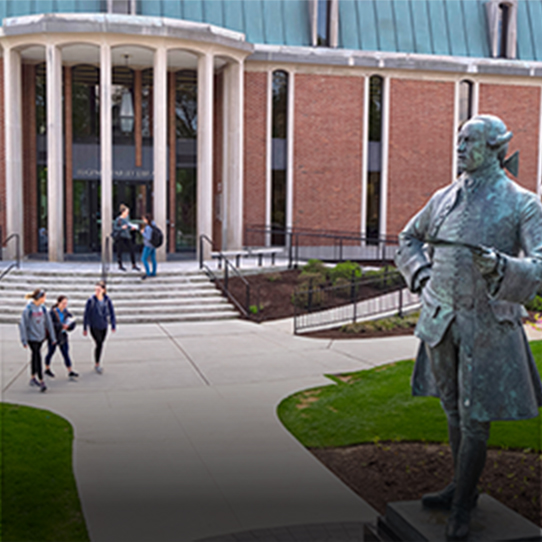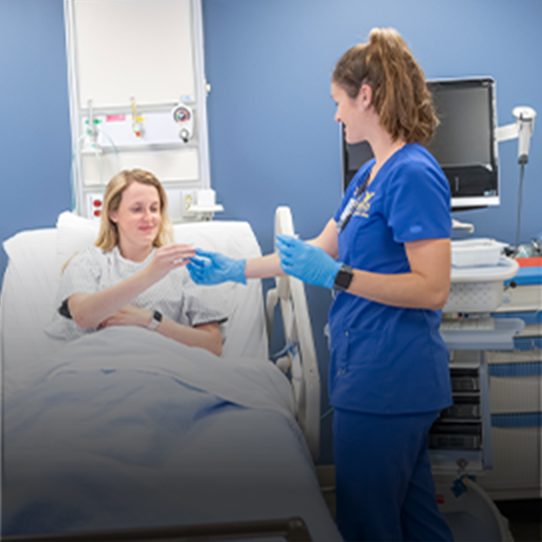What to Expect During a Nursing Clinical

When you think of nursing school, you may imagine the scene of a typical academic experience: scattered index cards on a desk, study guides marked with highlighter, and reference books piled high next to your laptop. To an extent, that scene would be an accurate one; a good nursing school requires a lot of studying and memorization, as well as instruction from qualified professors. But one of the most important aspects of nursing school doesn’t take place at a desk. We’re talking, of course, about the nursing school clinical.
A nurse’s clinical education is incredibly important. Clinicals introduce students to the hospital or healthcare setting and pair students with practicing professionals who show them what professional nursing is really like. Nursing school clinicals bridge the gap between the theoretical and the practical in a way that nothing else can. It is this hands-on time in the field that grounds nurses in an understanding of what their day-to-day work shifts could be like.
Clinicals can be intimidating, especially when you don’t know what to expect. But this part of the nursing education process is crucial to learning how to care for patients and implement what you’ve learned. Many nurses even say that clinicals were their favorite part of nursing school.
Let’s dive into the clinical placement process, the instructors, and what you’ll actually do during your nursing clinical education.
What are nursing clinicals?
Nursing clinical rotations are educational hours where nursing students can practice what they are learning in their classes. Though hours spent in clinicals are unpaid, nursing students gain work experience. They also get a grade based on their performance during their clinical education.
Clinicals typically start during your first or second semester of any nursing school program. Nursing students do several rounds of clinical rotations, usually each semester in a different health care setting.
These clinical rotations typically happen two to three days per week during the academic semester. Shifts will vary in length according to the setting. They may be four-to-six-hour shifts or eight-to-twelve-hour shifts. A clinical supervisor will be available to monitor and advise nursing students, and clinical shifts always involve observation and feedback from a licensed and active registered nurse (RN).
Clinical hour requirements vary from state to state and from program to program. The minimum amount of time you’ll need to spend doing clinical rotations will be determined by the nursing board of the state where your program is located.

What are nursing students expected to do during clinicals?
What actually happens during nursing clinicals will vary according to the setting where they take place. Clinical rotations for nurses may happen in labor and delivery wards, long-term care facilities, surgical clinics, pediatrician’s offices, mental health facilities, and many more health care settings.
In some cases, you may work with a nurse one-on-one, partnering with them throughout the day as they take care of patients. In other cases, you may be placed with a group of other student nurses with a faculty member supervising the group.
Before the start of a clinical shift, your clinical instructor will go over their expectations for the day. They may discuss how what you’re learning in the classroom is related to the day’s clinical assignments. You may be tasked with some patient care or simply follow along and seek out patient care opportunities with your preceptor throughout their shift. After every shift, there will be time for questions and a review of what happened that day.
Nursing students can’t perform work that legally requires an RN license, but they are authorized to practice their skills and do some basic nursing tasks under the supervision of a licensed RN. General nursing tasks that students often perform during clinicals include:
- Practicing the patient intake process and taking medical histories
- Completing components of patient assessment
- Communicating findings and collaborating with health care team members
- Obtaining vital signs, like blood pressure and temperature checks
- Administering some medication
- Assisting patients with activities of daily living
Nursing students are expected to show up at clinicals the way that they would appear for work as an RN. That means arriving promptly in clean scrubs, typically in your school’s colors, and wearing an ID or name tag from the health care facility. Comfortable, closed-toed shoes and hair that is pulled away from the face are also common requirements. Depending on the facility, you may also wear a face mask, gloves, and/or other personal protection equipment during your shift.
Students are evaluated based on their attendance and participation. They may also sometimes be assigned homework specific to their clinical assignment.
How does placement for clinical rotations work?
So how do you find a healthcare setting that will let you observe and practice your nursing skills for nursing school credit?
The answer is, it depends on your program. Some online programs have a clinical placement team that will provide clinical placement services for students. In these cases, the team handles the majority of communication with the placement site, including confirming the placement site as well as communicating dress code and professional expectations with the student.
The accrediting body for any nursing program will decide how many hours you need and the acceptable way for you to acquire them. The state of Pennsylvania itself does not prescribe a set number of clinical hours for licensure at this time.
Learn more about the ABSN
If you’re in an online program, knowing that you’re getting regular exposure to practicing medical professionals can be a huge confidence booster as you advance in your nursing education. Your clinical nursing education also adds vital knowledge, experience, and professional connections to your professional resume.
Wilkes University online offers placement assistance for all students in their nursing programs, including its online BSN program. Wilkes has a strong rate of success in securing placements for students’ clinical observations, which means that the chances are incredibly high that they will be able to find you an acceptable clinical placement where you can learn how your classroom knowledge translates in the real world of helping patients.
Wilkes’ online accelerated BSN (ABSN) program can be completed in as little as 15 months. With Wilkes managing the heavy lifting of your required clinical placement, you’ll be free to focus on your studies. The ABSN program also requires a short on-campus residency where students are further immersed in applying their academic knowledge to practice situations.
Learn more about the online ABSN at Wilkes by checking out the program guide.




